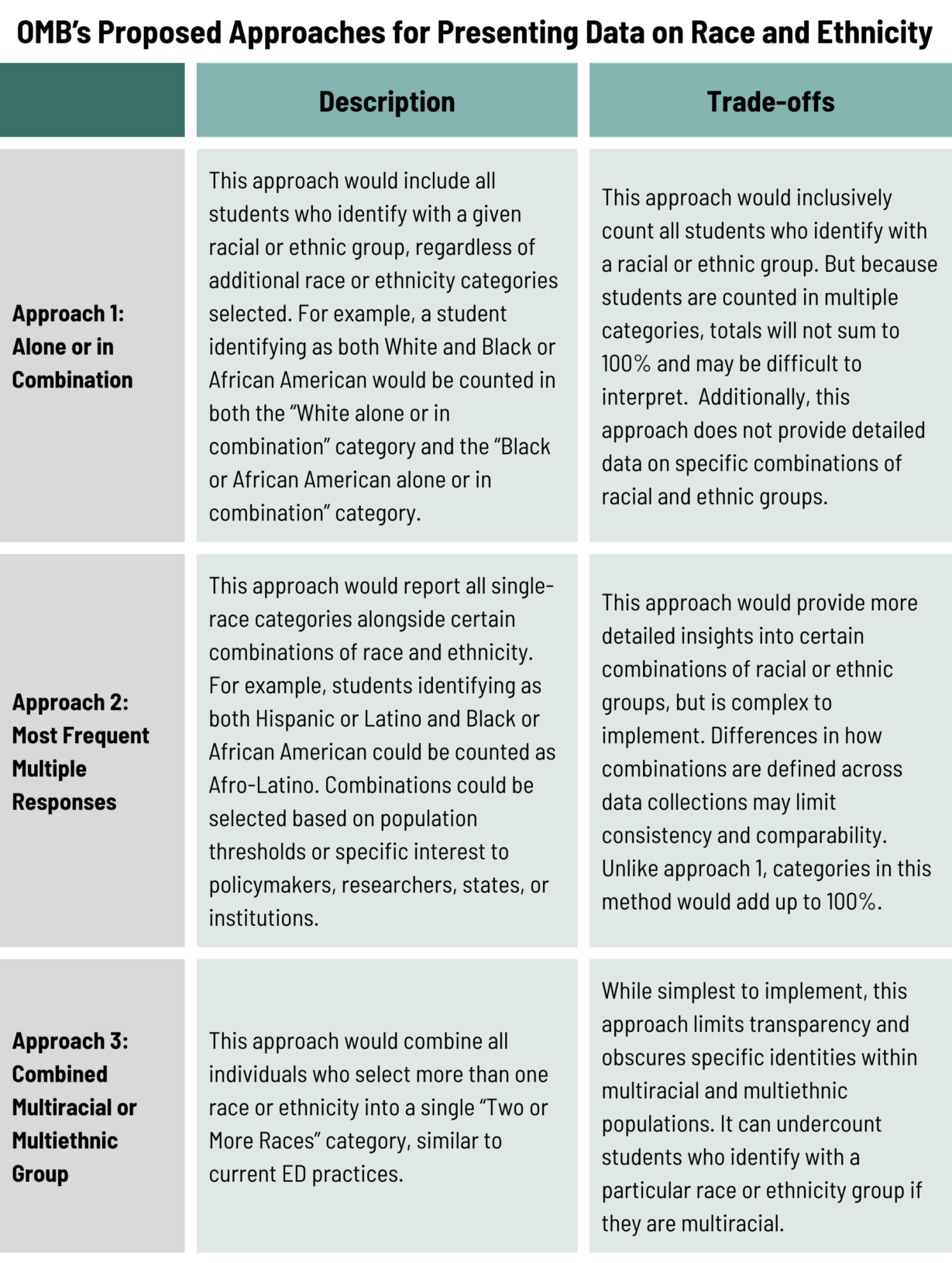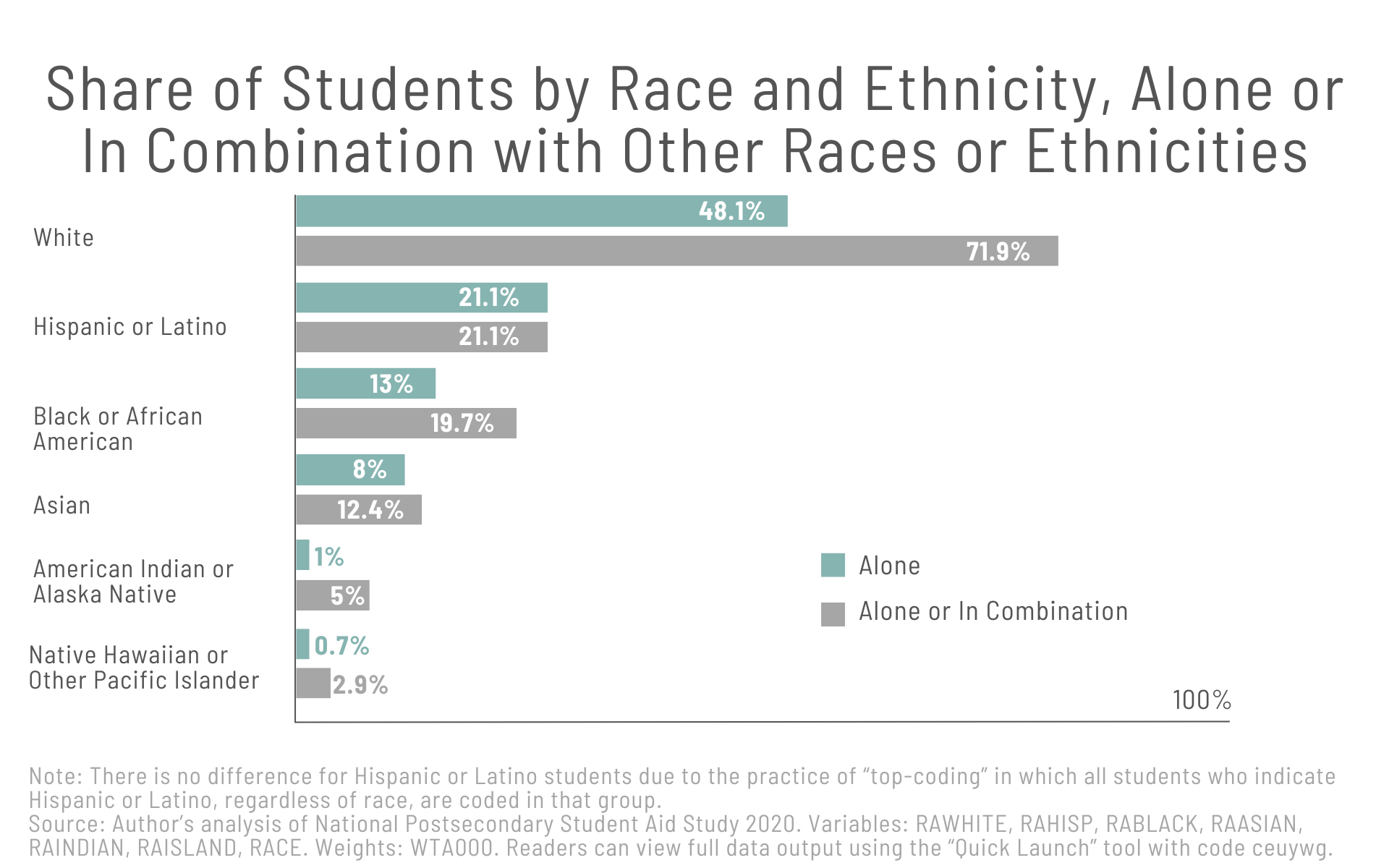Making Multiracial Students Count: Improving the Way Higher Ed Presents Race and Ethnicity Data
Published Aug 2025
As the U.S. becomes more racially and ethnically diverse, how data are collected and presented plays a critical role in ensuring that all students’ identities are accurately represented. The U.S. multiracial population nearly quadrupled between 2010 and 2020, growing from 9 million to 33.8 million. This increase has been driven by demographic shifts and improved Census methods that make it easier for individuals to self-identify with more than one race. Reflecting this broader trend, the share of multiracial students enrolled in college more than doubled between 2011 and 2021, rising from 2.1 percent to 4.3 percent, and is projected to reach nearly one in twenty students by 2031. However, higher education data systems have not kept pace with the complexity of students’ racial and ethnic identities.
Current data practices mask important information about students who identify with more than one race or ethnicity. For example, it is common to combine multiracial and multiethnic students into a catch-all “Two or more races” category. Using this approach, a student who identifies as both “Black or African American” and “American Indian or Alaska Native” would not be counted in either individual category, but rather in the “Two or more races” category. Data presentation practices like this undercount students who identify with multiple racial or ethnic groups and can lead to data suppression for small populations like American Indian or Alaska Native students.
New federal standards for collecting and presenting race and ethnicity data offer an opportunity for improvement, including by the U.S. Department of Education (ED), which must adhere to these updated requirements. Institutions, systems, states, and other data stewards should also reassess their data practices to better count multiracial and multiethnic students and to align with these updated federal requirements. All federal agencies are required to develop and publish action plans by September 28, 2025, with full implementation of the standards by March 28, 2029.
Approaches for Presenting Data on Multiracial and Multiethnic Students
In March 2024, the Office of Management and Budget (OMB) released updates to Statistical Policy Directive No. 15 (SPD 15). These updated standards propose three approaches for presenting data on multiracial or multiethnic individuals, each with trade-offs related to visibility, inclusiveness, and usability for practice, research, and policymaking.

These approaches provide a starting point for thinking critically about how to represent multiracial and multiethnic students more accurately in data collections. Data collectors should consider:
- What are the data collections designed to inform and support?
- Does the approach increase visibility for multiracial students?
- What is the reporting burden, relative to the benefits?
- Are students self-reporting their race and ethnicity, or are data being reported on their behalf?
- Does the approach support meaningful and useful analyses and informed policy?
Data collectors can also consider modifying or combining methods. For example, data collectors could present both “alone” and “alone or in combination” categories to offer inclusive counts and maintain mutually exclusive groups for analysis. This combined approach helps protect student privacy for groups with small sample sizes and maintain consistency across different collections while reducing reporting burden.
How Different Data Approaches Can More Inclusively Count Multiracial Students
As shown in the graph below, the “alone or in combination” approach represents a major improvement on existing reporting standards and provides a clearer picture of representation across specific groups. Nationally representative data show that including multiracial students increases the percentage of students who identify with each race and ethnicity category.

The “alone or in combination” approach is especially crucial for accurately counting American Indian or Alaska Native (AI/AN) or Native Hawaiian or Other Pacific Islander (NHPI) students. Although only 1 percent of students identify as AI/AN alone, that number increases fivefold when students who identify as AI/AN in combination with any other race are included. The NHPI student population shows a similar pattern, rising from 0.7 percent to about 3 percent, when multiracial identities are counted. These differences highlight how improvements to data presentation can make visible smaller populations who have historically been undercounted or overlooked in traditional reporting.
Recommendations for Improving Data Presentation on Multiracial and Multiethnic Students
Three recommendations detail how to strengthen federal, state, college system, and individual colleges’ data collection practices by adopting more inclusive presentation approaches.
Disaggregate Multiracial and Multiethnic Student Data
Avoid grouping all multiracial and multiethnic students into a single catch-all category. Instead, consider presentation approaches that increase visibility of multiracial students and better represent students’ identities and experiences. This may include counting students in all racial and ethnic groups they identify with or presenting data on specific identity combinations of race and ethnicity, such as Afro-Latino. Input from students, local communities, and stakeholders should inform decisions about data presentation practices.
Provide Clear Guidance and Support
To enhance accuracy and minimize reporting burden, data collectors should offer clear guidance and support to data reporters. ED should provide timely and transparent details on its plan to implement SPD 15 giving states, systems, and institutions the structure needed to align their own data practices. Support from ED should include guidance, resources, training, technical assistance, and detailed documentation. ED should also ensure that implementation timelines allow institutions sufficient time to adjust data practices.
Invest in Capacity
Improving data practices requires intentional investments in staffing, technical infrastructure, and support systems. Institutions, systems, and states should proactively allocate resources for their data efforts, ensuring that reporting teams have the tools and time necessary to carry out this work effectively. Investments may include upgrades to student information systems and data platforms, professional development and training for data and research staff, and structures that support collaboration between institutional research, student support offices, and leadership. Technical assistance must be accessible, particularly for institutions with limited capacity or high administrative burden.
As multiracial and multiethnic students make up a larger share of the U.S. college-going population, data systems must evolve to reflect their identities and experiences. When data reflect the full complexity of students’ identities, decisionmakers are better equipped to identify disparities and design policies that support the needs of all students. By improving data practices for multiracial and multiethnic students, the higher education field can move closer to ensuring every student is fully seen, counted, and supported.
Acknowledgements
We would like to thank the individuals who supported the development of this brief, including Diane Cheng, vice president of policy; Kim Dancy, director of research; and Lauren Bell, communications manager.
All ideas, findings, and conclusions drawn by this report are the sole responsibility of the report’s authors
